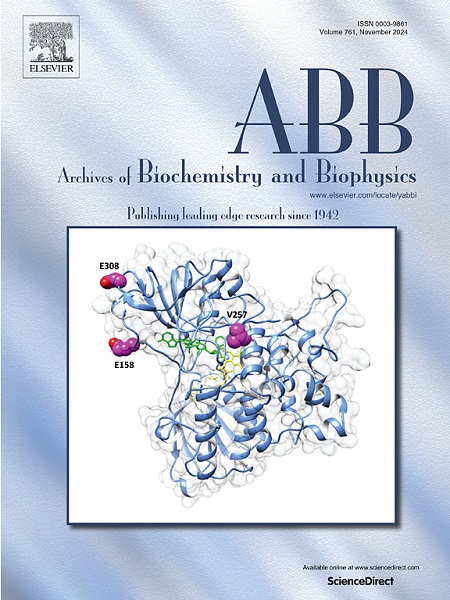CaMKIIα 半胱氨酸的氧化抑制了磷酸化诱导的自主激活。
IF 3.8
3区 生物学
Q2 BIOCHEMISTRY & MOLECULAR BIOLOGY
引用次数: 0
摘要
Ca2+/钙调素依赖性蛋白激酶IIα (CaMKIIα)Thr286磷酸化诱导的“自主”激活在突触可塑性中起着至关重要的作用。先前的研究表明,在阿尔茨海默病的大脑中,CaMKIIα Thr286的自磷酸化水平降低,而半胱氨酸氧化的CaMKIIα水平升高。我们对氧化CaMKIIα进行了色氨酸定位,发现在n端Cys6和调节结构域Cys280之间形成了二硫化物。Cys6和Cys280的表观pKa值分别为7.1和7.7,低于游离Cys的8.5。Cys280的低表观pKa有利于其硫醇在生理ph下氧化为硫酸,然后Cys280的硫醇可以攻击硫酸形成二硫化物。利用抗磷酸化Thr286的抗体,我们发现二硫化物的形成阻止了Thr286的磷酸化。CaMKIIα由二硫化物形成诱导的自主激活远低于磷酸化诱导的自主激活。自主激活的减少可能与阿尔茨海默病的突触损伤有关。我们还生成了CaMKIIα突变体,其中Cys6突变为Ser6。这种突变阻止了二硫化物的形成,并恢复了磷酸化诱导的自主激活。我们的研究结果提供了对CaMKIIα自主激活的机制细节的深入了解,CaMKIIα自主激活可能导致阿尔茨海默病的长期增强功能受损。本文章由计算机程序翻译,如有差异,请以英文原文为准。

Oxidation of CaMKIIα cysteines inhibits autonomous activation induced by phosphorylation
Ca2+/calmodulin-dependent protein kinase II α (CaMKIIα) “autonomous” activation induced by Thr286 phosphorylation has a crucial role in synaptic plasticity. Previous studies showed that in Alzheimer's disease brain, CaMKIIα autophosphorylation at Thr286 is reduced while the level of cysteine-oxidized CAMKIIα is elevated. We performed tryptic mapping of the oxidized CaMKIIα and discovered the formation of a disulfide between the N-terminal Cys6 and the regulatory domain Cys280. The apparent pKa values of Cys6 and Cys280 are 7.1 and 7.7, respectively, lower than the 8.5 for free Cys. The low apparent pKa of Cys6 facilitates the oxidation of its thiol to the sulfenic acid at physiological pH. The thiolate of Cys280 can then attack the sulfenic acid to form a disulfide. Using an antibody against phosphorylated Thr286, we showed that disulfide formation prevents Thr286 phosphorylation. CaMKIIα autonomous activation induced by disulfide formation is much lower than the autonomous activation induced by phosphorylation. The decreased autonomous activation may contribute to the synaptic impairment of Alzheimer's disease. We also generated a CaMKIIα mutant in which Cys6 was mutated to Ser6. This mutation prevented disulfide formation and restored autonomous activation induced by phosphorylation. Our findings provide insight into the mechanistic details of CaMKIIα autonomous activation induced by disulfide formation that may contribute to the impairment of long-term potentiation in Alzheimer's disease.
求助全文
通过发布文献求助,成功后即可免费获取论文全文。
去求助
来源期刊

Archives of biochemistry and biophysics
生物-生化与分子生物学
CiteScore
7.40
自引率
0.00%
发文量
245
审稿时长
26 days
期刊介绍:
Archives of Biochemistry and Biophysics publishes quality original articles and reviews in the developing areas of biochemistry and biophysics.
Research Areas Include:
• Enzyme and protein structure, function, regulation. Folding, turnover, and post-translational processing
• Biological oxidations, free radical reactions, redox signaling, oxygenases, P450 reactions
• Signal transduction, receptors, membrane transport, intracellular signals. Cellular and integrated metabolism.
 求助内容:
求助内容: 应助结果提醒方式:
应助结果提醒方式:


